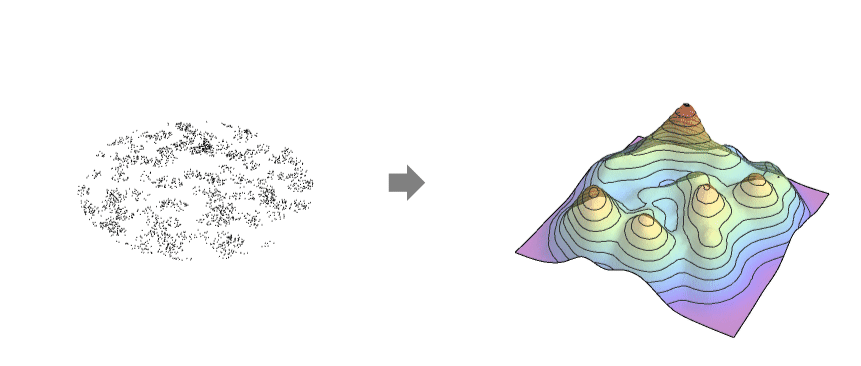SmoothPointDensity
SmoothPointDensity[pdata]
估计点数据 pdata 的点密度函数 ![]() .
.
SmoothPointDensity[pdata,bw]
用带宽 bw 估计点数据 pdata 的密度.
SmoothPointDensity[pdata,bw,ker]
用带宽 bw、平滑内核 ker 估计点数据 pdata 的密度.
SmoothPointDensity[bdata,…]
估计已分组数据 bdata 的点密度函数 ![]() .
.
SmoothPointDensity[pproc,…]
计算点过程 pproc 的密度函数 ![]() .
.
更多信息和选项




- 点密度亦称为点强度.
- SmoothPointDensity 给出函数
 ,描述在观察区域
,描述在观察区域  中点数
中点数  怎样随长度、面积和体积变化. 区域上的积分为总的点数
怎样随长度、面积和体积变化. 区域上的积分为总的点数  .
. - SmoothPointDensity 是基于内核的点密度估计器,其中带宽 bw 和内核 ker 用于控制平滑程度.
- SmoothPointDensity 返回一个 PointDensityFunction,可用于重复计算密度函数.
- 点 pdata 可采用以下形式:
-
{p1,p2,…} 点 pi GeoPosition[…],GeoPositionXYZ[…],… 地理点 SpatialPointData[…] 空间点集 {pts,reg} 点集 pts 和观察区域 reg - 如果没有给出观察区域 reg,则用 RipleyRassonRegion 自动计算区域.
- 可用以下形式给出点过程 pproc:
-
proc 点过程 proc {proc,reg} 点过程 proc 和观察区域 reg - 观察区域 reg 不应含有任何参数,应是全维的和有界的,SpatialObservationRegionQ 的结果应为真.
- 对于点过程 pproc,使用精确公式或近似计算方法.
- 可给出以下带宽指定 bw:
-
h 使用的带宽 {"Standardized",h} 以标准偏差为单位的带宽 {"Adaptive",h,s} 初始带宽为 h,灵敏度为 s ,自适应选择带宽 Automatic 自动计算带宽 "name" 使用已命名的带宽选择方法 {bwx,bwy,…} 为 x、y 等分别指定带宽 - 对于多元密度,h 可以是一个正定对称矩阵.
- 对于自适应性带宽,灵敏度 s 必须是 0 到 1 之间的实数或 Automatic. 如果使用 Automatic,s 被设为
 ,其中
,其中  为数据的维度.
为数据的维度. - 可能的已命名的带宽选择方法包括:
-
"LeastSquaresCrossValidation" 使用最小二乘交叉验证的方法 "Oversmooth" 标准高斯法的 1.08 倍 "Scott" 用 Scott 法则确定带宽 "SheatherJones" 使用 Sheather–Jones 插件估算器 "Silverman" 使用 Silverman 法则确定带宽 "StandardDeviation" 用标准偏差作为带宽 "StandardGaussian" 标准正态数据的最佳带宽 - 默认情况下,使用 "Silverman".
- 如果自动计算带宽,假定常数数组具有单位方差.
- 可给出以下内核指定 ker:
-
"Biweight" 

"Cosine" 

"Epanechnikov" 

"Gaussian" 

"Rectangular" 

"SemiCircle" 

"Triangular" 

"Triweight" 

func 

- 默认情况下,使用 "Gaussian" 内核.
- 对于多元密度,可通过 {"Product",ker} 和 {"Radial",ker} 将内核函数 ker 指定为 product 和 radial 类型. 如果没有指定类型,则使用 product 类型的内核.
- 用于密度估计的精度是 bw 和数据中给出的最小精度.
- 可给出以下选项:
-
Method Automatic 估计时使用的方法 - Method 的可能的设置为 Automatic、"KernelMixture"、"SmoothKernel".
- "KernelMixture" 方法的可能的子选项为:
-
MaxMixtureKernels Automatic 最多使用多少个内核 - "SmoothKernel" 方法的可能的子选项为:
-
InterpolationPoints Automatic 使用的初始插值点数 MaxMixtureKernels Automatic 最多使用多少个内核 MaxRecursion Automatic 允许进行多少次递归细分 PerformanceGoal Automatic 优化目标是速度还是质量 MaxExtraBandwidths Automatic 数据之外的最大带宽


范例
打开所有单元关闭所有单元基本范例 (1)
范围 (4)
创建均匀单变量 SpatialPointData:
创建非均匀单变量 SpatialPointData:
文本
Wolfram Research (2020),SmoothPointDensity,Wolfram 语言函数,https://reference.wolfram.com/language/ref/SmoothPointDensity.html.
CMS
Wolfram 语言. 2020. "SmoothPointDensity." Wolfram 语言与系统参考资料中心. Wolfram Research. https://reference.wolfram.com/language/ref/SmoothPointDensity.html.
APA
Wolfram 语言. (2020). SmoothPointDensity. Wolfram 语言与系统参考资料中心. 追溯自 https://reference.wolfram.com/language/ref/SmoothPointDensity.html 年